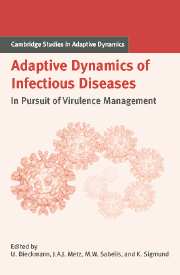Book contents
- Frontmatter
- Contents
- Contributing Authors
- List of Boxes
- Notational Standards
- 1 Introduction
- A Setting the Stage
- Introduction to Part A
- 2 Alternative Transmission Modes and the Evolution of Virulence
- 3 Wildlife Perspectives on the Evolution of Virulence
- 4 Adaptive Dynamics of Pathogen–Host Interactions
- 5 Dilemmas in Virulence Management
- B Host Population Structure
- C Within-Host Interactions
- D Pathogen–Host Coevolution
- E Multilevel Selection
- F Vaccines and Drugs
- G Perspectives for Virulence Management
- References
- Index
- International Institute for Applied Systems Analysis
Introduction to Part A
Published online by Cambridge University Press: 15 January 2010
- Frontmatter
- Contents
- Contributing Authors
- List of Boxes
- Notational Standards
- 1 Introduction
- A Setting the Stage
- Introduction to Part A
- 2 Alternative Transmission Modes and the Evolution of Virulence
- 3 Wildlife Perspectives on the Evolution of Virulence
- 4 Adaptive Dynamics of Pathogen–Host Interactions
- 5 Dilemmas in Virulence Management
- B Host Population Structure
- C Within-Host Interactions
- D Pathogen–Host Coevolution
- E Multilevel Selection
- F Vaccines and Drugs
- G Perspectives for Virulence Management
- References
- Index
- International Institute for Applied Systems Analysis
Summary
Investigating options for virulence management is a multidisciplinary endeavor. To identify the most promising avenues, contributions from epidemiology, ecology, microbiology, genetics, and theoretical biology have to be integrated into a common perspective. That goal is an inspiration and challenge for this book as a whole.
Before diving into this complexity, some readers might appreciate a gentle start. Part A therefore introduces the essential ideas and concepts in this book and addresses the following questions:
Is it realistic to expect measures of virulence management to succeed in practice?
What are the epidemiological and ecological complexities that virulence management strategies ultimately may have to deal with?
Which methods are suitable for assessing outcomes of virulence evolution and for predicting consequences of managerial interference?
Which problems and dilemmas are bound to arise in the context of virulence management efforts?
Chapter 2 provides first suggestions of management options that can successfully influence the virulence of pathogens. Ewald and De Leo emphasize the critical importance of the mode of pathogen transmission for virulence evolution. They propose that, if pathogens can be transmitted from host to host along several routes, public health managers should be concerned primarily with those routes that are least dependent on the host's health. Taking waterborne transmission as an example, a model of diarrheal disease is presented. Maximization of the basic reproduction ratio shows that, when waterborne transmission prevails, evolutionarily stable levels of virulence tend to be high.
- Type
- Chapter
- Information
- Adaptive Dynamics of Infectious DiseasesIn Pursuit of Virulence Management, pp. 8 - 9Publisher: Cambridge University PressPrint publication year: 2002



